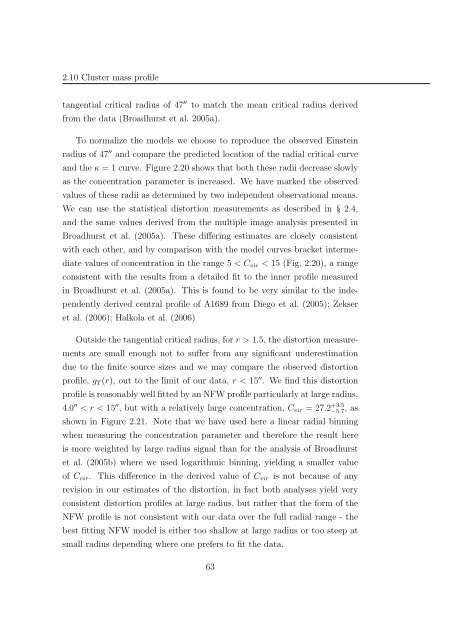Mass and Light distributions in Clusters of Galaxies - Henry A ...
Mass and Light distributions in Clusters of Galaxies - Henry A ...
Mass and Light distributions in Clusters of Galaxies - Henry A ...
You also want an ePaper? Increase the reach of your titles
YUMPU automatically turns print PDFs into web optimized ePapers that Google loves.
2.10 Cluster mass pr<strong>of</strong>ile<br />
tangential critical radius <strong>of</strong> 47 ′′ to match the mean critical radius derived<br />
from the data (Broadhurst et al. 2005a).<br />
To normalize the models we choose to reproduce the observed E<strong>in</strong>ste<strong>in</strong><br />
radius <strong>of</strong> 47 ′′ <strong>and</strong> compare the predicted location <strong>of</strong> the radial critical curve<br />
<strong>and</strong> the κ = 1 curve. Figure 2.20 shows that both these radii decrease slowly<br />
as the concentration parameter is <strong>in</strong>creased. We have marked the observed<br />
values <strong>of</strong> these radii as determ<strong>in</strong>ed by two <strong>in</strong>dependent observational means.<br />
We can use the statistical distortion measurements as described <strong>in</strong> § 2.4,<br />
<strong>and</strong> the same values derived from the multiple image analysis presented <strong>in</strong><br />
Broadhurst et al. (2005a). These differ<strong>in</strong>g estimates are closely consistent<br />
with each other, <strong>and</strong> by comparison with the model curves bracket <strong>in</strong>termediate<br />
values <strong>of</strong> concentration <strong>in</strong> the range 5 < C vir < 15 (Fig. 2.20), a range<br />
consistent with the results from a detailed fit to the <strong>in</strong>ner pr<strong>of</strong>ile measured<br />
<strong>in</strong> Broadhurst et al. (2005a). This is found to be very similar to the <strong>in</strong>dependently<br />
derived central pr<strong>of</strong>ile <strong>of</strong> A1689 from Diego et al. (2005); Zekser<br />
et al. (2006); Halkola et al. (2006)<br />
Outside the tangential critical radius, for r > 1.5, the distortion measurements<br />
are small enough not to suffer from any significant underestimation<br />
due to the f<strong>in</strong>ite source sizes <strong>and</strong> we may compare the observed distortion<br />
pr<strong>of</strong>ile, g T (r), out to the limit <strong>of</strong> our data, r < 15 ′′ . We f<strong>in</strong>d this distortion<br />
pr<strong>of</strong>ile is reasonably well fitted by an NFW pr<strong>of</strong>ile particularly at large radius,<br />
4.0 ′′ < r < 15 ′′ , but with a relatively large concentration, C vir = 27.2 +3.5<br />
−5.7, as<br />
shown <strong>in</strong> Figure 2.21. Note that we have used here a l<strong>in</strong>ear radial b<strong>in</strong>n<strong>in</strong>g<br />
when measur<strong>in</strong>g the concentration parameter <strong>and</strong> therefore the result here<br />
is more weighted by large radius signal than for the analysis <strong>of</strong> Broadhurst<br />
et al. (2005b) where we used logarithmic b<strong>in</strong>n<strong>in</strong>g, yield<strong>in</strong>g a smaller value<br />
<strong>of</strong> C vir . This difference <strong>in</strong> the derived value <strong>of</strong> C vir is not because <strong>of</strong> any<br />
revision <strong>in</strong> our estimates <strong>of</strong> the distortion, <strong>in</strong> fact both analyses yield very<br />
consistent distortion pr<strong>of</strong>iles at large radius, but rather that the form <strong>of</strong> the<br />
NFW pr<strong>of</strong>ile is not consistent with our data over the full radial range - the<br />
best fitt<strong>in</strong>g NFW model is either too shallow at large radius or too steep at<br />
small radius depend<strong>in</strong>g where one prefers to fit the data.<br />
63
















